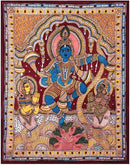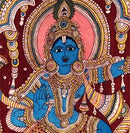The beautiful Kalamkari painting depicts the "Lord Krishna vanquishing the serpents (Kaliya). There was a great lake within the river Yamuna and in that lake resided the black and venomous serpent Kaliya. Due to the poisonous vapors emanated by him, the surrounding area was so contaminated that no living being would dare venture near the place. One day Krishna’s fellow cowherds went near the lake and after drinking water fell sick. Krishna after learning this said: “I shall vanquish this king of serpents and release the inhabitants of the country from their continual dread.” Following a fierce battle, Krishna overpowered the serpents and following the prayers by the wives of the Kaliya, he pardoned Kaliya on the condition that Kaliya would leave the place forever. The manner in which Krishna subdues Kaliya has a fascinating quality about it. The dance to victory, the effortless rhythm of the Almighty's pace of creation and destruction, the ease, the grace, the sheer play in the manifestations of the Lord's will, to which wind and water provide enchanted accompaniment, are beautifully brought out in the narrative. Indeed, this is the first inkling in textual material of Krishna as ‘natwar’ (the dancer) Figuratively, the image of Krishna dancing over the serpent is a motif symbolizing the inverted tree of life with the outstretched hoods signifying its roots. Additionally, Kaliya's name is derived from 'kala,' the word for time in Sanskrit, making this a dance of victory over time and death as well, or in other words, the triumph of the eternal over the transient.
Description
The beautiful Kalamkari painting depicts the "Lord Krishna vanquishing the serpents (Kaliya). There was a great lake within the river Yamuna and in that lake resided the black and venomous serpent Kaliya. Due to the poisonous vapors emanated by him, the surrounding area was so contaminated that no living being would dare venture near the place. One day Krishna’s fellow cowherds went near the lake and after drinking water fell sick. Krishna after learning this said: “I shall vanquish this king of serpents and release the inhabitants of the country from their continual dread.” Following a fierce battle, Krishna overpowered the serpents and following the prayers by the wives of the Kaliya, he pardoned Kaliya on the condition that Kaliya would leave the place forever. The manner in which Krishna subdues Kaliya has a fascinating quality about it. The dance to victory, the effortless rhythm of the Almighty's pace of creation and destruction, the ease, the grace, the sheer play in the manifestations of the Lord's will, to which wind and water provide enchanted accompaniment, are beautifully brought out in the narrative. Indeed, this is the first inkling in textual material of Krishna as ‘natwar’ (the dancer) Figuratively, the image of Krishna dancing over the serpent is a motif symbolizing the inverted tree of life with the outstretched hoods signifying its roots. Additionally, Kaliya's name is derived from 'kala,' the word for time in Sanskrit, making this a dance of victory over time and death as well, or in other words, the triumph of the eternal over the transient.
Payment & Security
Your payment information is processed securely. We do not store credit card details nor have access to your credit card information.




